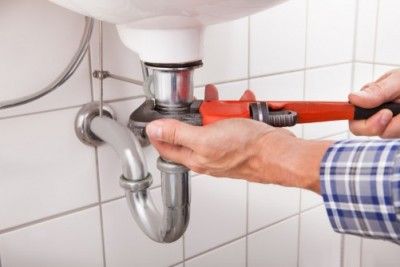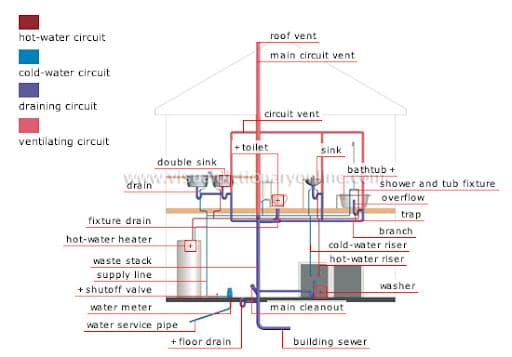The content below involving Exploring Your Homes Plumbing Anatomy is relatively interesting. Have a go and make your own results.

Comprehending just how your home's plumbing system works is necessary for every home owner. From providing tidy water for drinking, food preparation, and showering to securely removing wastewater, a well-maintained pipes system is important for your family's wellness and comfort. In this comprehensive guide, we'll explore the detailed network that comprises your home's plumbing and offer pointers on upkeep, upgrades, and dealing with usual problems.
Introduction
Your home's plumbing system is greater than simply a network of pipelines; it's a complicated system that ensures you have accessibility to tidy water and effective wastewater removal. Knowing its elements and just how they interact can assist you protect against pricey repairs and make certain everything runs efficiently.
Basic Parts of a Pipes System
Pipes and Tubes
At the heart of your plumbing system are the pipes and tubes that lug water throughout your home. These can be made from numerous products such as copper, PVC, or PEX, each with its advantages in regards to durability and cost-effectiveness.
Components: Sinks, Toilets, Showers, and so on.
Fixtures like sinks, bathrooms, showers, and bath tubs are where water is used in your house. Understanding exactly how these components attach to the plumbing system helps in detecting troubles and preparing upgrades.
Shutoffs and Shut-off Points
Shutoffs control the circulation of water in your plumbing system. Shut-off shutoffs are essential throughout emergencies or when you need to make repair services, allowing you to separate parts of the system without interrupting water circulation to the entire residence.
Supply Of Water System
Key Water Line
The main water line attaches your home to the community water system or an exclusive well. It's where water enters your home and is distributed to different components.
Water Meter and Stress Regulatory Authority
The water meter actions your water usage, while a pressure regulator makes certain that water streams at a risk-free stress throughout your home's plumbing system, stopping damages to pipelines and components.
Cold Water vs. Hot Water Lines
Recognizing the difference in between cold water lines, which provide water straight from the major, and warm water lines, which bring heated water from the water heater, helps in troubleshooting and planning for upgrades.
Drain System
Drain Piping and Traps
Drain pipelines lug wastewater far from sinks, showers, and toilets to the drain or septic system. Traps prevent drain gases from entering your home and additionally trap particles that can cause clogs.
Ventilation Pipes
Ventilation pipelines permit air right into the water drainage system, preventing suction that might slow water drainage and create traps to empty. Proper ventilation is important for maintaining the integrity of your pipes system.
Importance of Appropriate Drain
Guaranteeing appropriate water drainage stops back-ups and water damage. Routinely cleaning drains pipes and keeping catches can avoid costly repair work and prolong the life of your plumbing system.
Water Heating System
Types of Water Heaters
Water heaters can be tankless or traditional tank-style. Tankless heaters warmth water as needed, while containers store heated water for immediate use.
How Water Heaters Connect to the Plumbing System
Comprehending exactly how hot water heater link to both the cold water supply and warm water distribution lines helps in diagnosing concerns like not enough warm water or leakages.
Upkeep Tips for Water Heaters
Frequently flushing your water heater to eliminate debris, examining the temperature settings, and examining for leakages can expand its life expectancy and enhance energy effectiveness.
Common Plumbing Concerns
Leakages and Their Causes
Leaks can take place as a result of aging pipelines, loosened installations, or high water stress. Attending to leakages quickly protects against water damages and mold growth.
Obstructions and Obstructions
Clogs in drains pipes and bathrooms are often brought on by flushing non-flushable items or a build-up of oil and hair. Making use of drainpipe screens and being mindful of what decreases your drains can protect against blockages.
Signs of Pipes Issues to Watch For
Low tide stress, slow-moving drains, foul odors, or abnormally high water expenses are signs of possible pipes issues that ought to be addressed immediately.
Plumbing Upkeep Tips
Routine Inspections and Checks
Set up yearly plumbing examinations to catch concerns early. Search for signs of leakages, rust, or mineral buildup in taps and showerheads.
DIY Upkeep Tasks
Basic tasks like cleansing faucet aerators, looking for commode leaks using dye tablet computers, or insulating exposed pipelines in cold climates can protect against major pipes issues.
When to Call an Expert Plumbing
Know when a pipes issue calls for expert knowledge. Trying complex repairs without proper expertise can result in more damages and greater repair work expenses.
Updating Your Pipes System
Reasons for Updating
Updating to water-efficient fixtures or changing old pipes can improve water high quality, minimize water bills, and boost the worth of your home.
Modern Plumbing Technologies and Their Advantages
Explore modern technologies like smart leakage detectors, water-saving commodes, and energy-efficient hot water heater that can save cash and lower environmental impact.
Expense Factors To Consider and ROI
Calculate the in advance prices versus long-term cost savings when taking into consideration plumbing upgrades. Several upgrades spend for themselves through minimized energy costs and less repairs.
Environmental Effect and Conservation
Water-Saving Components and Devices
Installing low-flow faucets, showerheads, and bathrooms can dramatically minimize water use without giving up performance.
Tips for Lowering Water Usage
Easy routines like dealing with leaks quickly, taking shorter showers, and running complete loads of laundry and meals can preserve water and reduced your energy bills.
Eco-Friendly Pipes Options
Consider sustainable plumbing products like bamboo for floor covering, which is durable and green, or recycled glass for kitchen counters.
Emergency Preparedness
Actions to Take Throughout a Pipes Emergency situation
Know where your shut-off shutoffs lie and how to turn off the water in case of a burst pipeline or significant leakage.
Value of Having Emergency Situation Calls Helpful
Keep call details for neighborhood plumbers or emergency services readily available for quick response throughout a pipes situation.
DIY Emergency Fixes (When Appropriate).
Momentary fixes like using duct tape to spot a dripping pipeline or putting a container under a dripping faucet can decrease damages up until an expert plumbing arrives.
Verdict.
Recognizing the composition of your home's pipes system equips you to preserve it effectively, conserving money and time on repairs. By adhering to routine maintenance routines and remaining notified regarding contemporary plumbing technologies, you can guarantee your plumbing system operates successfully for many years to find.
HOW YOUR PLUMBING SYSTEM WORKS
Which Pipes Do What?
- Blue lines = fresh water supply entering the building
- Red lines = hot water supply entering the building
- Grey lines = pipes carrying waste away from the building and venting pipes carrying gases away from the building (through the roof)
YOUR MAIN PLUMBING SYSTEMS
There are two main plumbing systems that support your home s basic plumbing needs one that brings clean water into your home, and one that sends dirty water away from your home. Connected to the toilet, bath, shower, and other faucets in your home, these two systems keep your water flowing in the right directions.
ACCESSING FRESH WATER
Fresh and clean water is brought into your home through the main water supply line . Filtered through one pipe, this water is pressured to flow into the various fixtures in your home at any given time.
This water can be sourced from a well located on your property, a pond or river (mostly cottages), or, as in most cases, from the city s municipal water treatment centre. However, it is important to note that water that is untreated, such as the water siphoned from ponds or rivers, may not be safe to drink. Personal water supplies always need to be treated for hardness and contaminants before consumed.
MUNICIPAL WATER SUPPLIES
- Improve taste and odour
- Remove sediment
- Eliminate hardness
- Reduce chlorine
COLD WATER SUPPLY VS. HOT WATER SUPPLY
Cold water flows into your home or building through the service line, which then distributes hot or cold water to your fixtures. This line is most commonly run through a central column that runs floor to floor. Hot water runs in short and straight pipes as the longer the pipeline, the more heat that will be lost in the transfer. Having shorter pipes also allows residents to access hot water more quickly.
WASTE WATER SYSTEM
Your wastewater system is divided into two parts pipes that send wastewater away from your home and venting pipes that send sewer gas away from your home. Sewage water travels through pipes that flush the water and waste towards local sewers that are operated and managed by your city or town. Most sewer systems rely on gravity to move the wastewater to where it needs to go.
The further away from your toilet or sink, the larger wastewater pipes become. This allows for waste to be disposed of from various parts of your home or business at once without pipe blockages. The angle and flow of these pipes are also essential for keeping your waste pipes clear of build up.
https://harrisplumbing.ca/how-your-home-plumbing-system-works/

I was made aware of that write-up on The Inner Workings of Your Home's Plumbing through a buddy on our other site. Make sure you take the time to promote this page if you enjoyed it. Thank you for taking the time to read it.
Click Here
Comments on “A Detailed Look at Your Home's Plumbing System Anatomy”